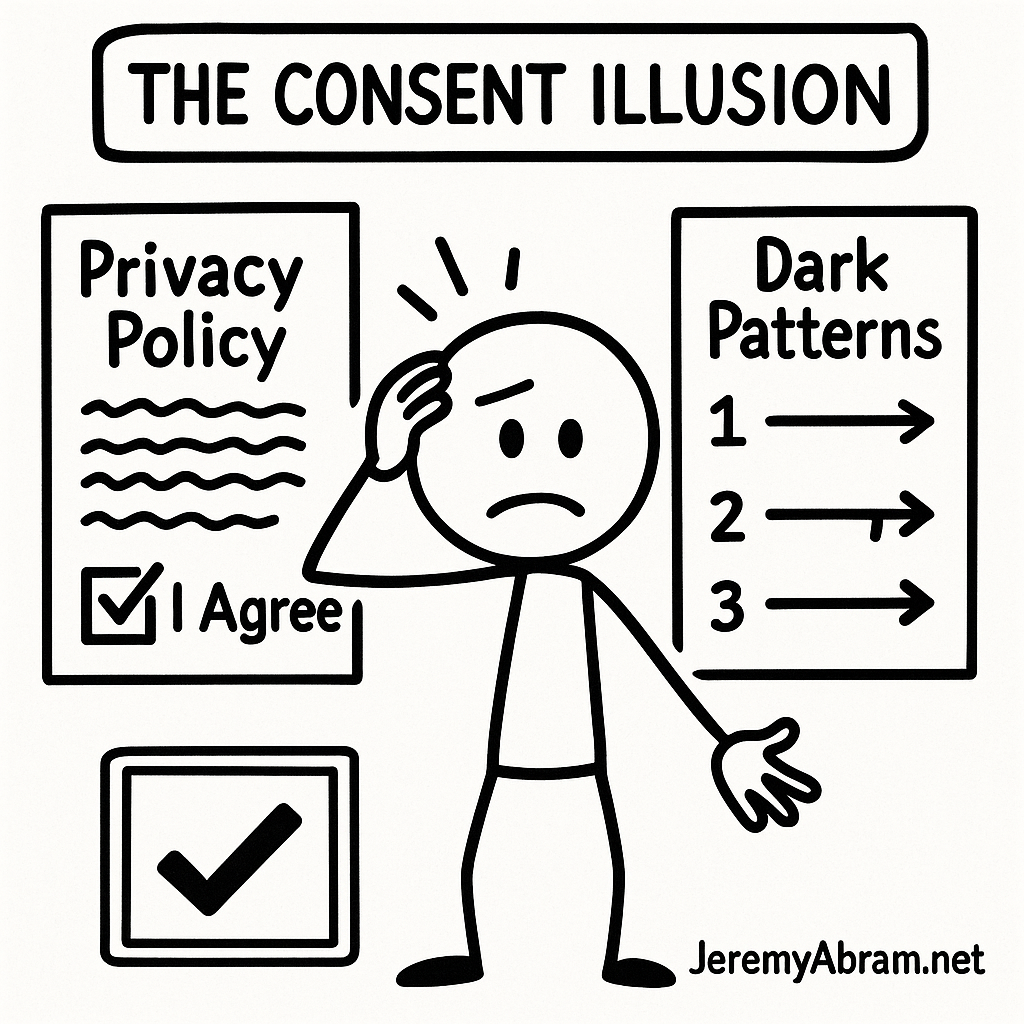
Every day, we click “I agree” — to apps, websites, services, platforms, and operating systems. It is the modern ritual of digital access. The confirmation box appears, the checkbox waits, and our reflex is automatic. Agree, continue, submit.
We like to believe this act represents informed consent — a deliberate, thoughtful decision about how our data will be used, stored, and shared. But in reality, it’s often nothing more than a conditioned gesture. A symbolic handshake with systems designed not to seek true consent, but to manufacture it.
Behind this seamless click lies a design philosophy: if users cannot be convinced to understand, they can be nudged to comply.
Welcome to the consent illusion.
The Problem Isn’t Just Fine Print — It’s Weaponized Design
Privacy policies weren’t created to inform the average person. They’re legal shields, drafted to protect companies, applied in environments where reading them is impractical — if not impossible.
The average privacy policy takes over 10 minutes to read and requires a college-level reading ability. Multiply that by the dozens of apps and sites we use monthly, and “informed consent” becomes a mathematical impossibility.
But the challenge is bigger than complexity. The modern consent process is built on three intertwined forces:
1. Legalese That Obscures, Not Explains
Privacy agreements are packed with:
- Vague phrases like “trusted partners” or “service providers”
- Broad permissions such as “improve user experience” or “functionality enhancements”
- Nested clauses that make opting out legally difficult
- Language that shifts responsibility to users (“By continuing to use this site…”)
These aren’t coincidences — they’re a form of structural opacity.
2. Dark Patterns Disguised as Choices
Tech platforms deploy UI tactics that guide users toward the outcome companies prefer:
- The big, colorful “Accept” button vs. a small, grayscale “Manage settings”
- “Reject all” hidden behind multiple layers
- Deliberately confusing toggles (opt-out disguised as opt-in)
- Automatic opt-ins with the burden placed on users to discover and change defaults
The illusion of choice becomes a channel for coercion.
3. Interface Psychology That Pressures Compliance
The consent flow feels routine and harmless. The interface encourages speed and convenience:
- Consent prompts interrupt tasks, making users eager to dismiss
- Friction is added only to privacy-friendly options
- Consent becomes synonymous with progress — you must click to proceed
You aren’t choosing; you’re being funneled.
Consent Fatigue: The Quiet Engine of Data Extraction
If privacy policies are walls, consent fatigue is the lubricant that helps users slide right through the cracks.
We are overwhelmed by:
- Notification banners
- Cookie pop-ups
- App permissions
- Security warnings
- Tracking disclosures
Humans weren’t designed for continuous consent arbitration. The brain defaults to autopilot — and that is exactly the point.
The more pop-ups we see, the less we question them.
Privacy becomes not a right but a tolerance threshold.
Why This Matters: We’re Not Agreeing — We’re Surrendering
Every friction-optimized click grants companies:
- Location data
- Movement and behavior traces
- Contacts and biometrics
- Speech, keystrokes, browsing, purchase, and emotional patterns
- Cross-platform identity linkage
We aren’t just consenting to data collection —
we are consenting to surveillance as a business model.
And once consent is obtained (manufactured or not), companies position themselves as compliant rather than intrusive.
The checkbox absolves. The user is blamed. The system moves on.
A Better Way Forward: Consent That Respects Humans
Real consent requires:
- Plain-language policies
- Layered summaries (two sentences before 20 pages)
- Neutral UI patterns — no visual nudging
- True “Reject all” options with equal prominence
- Data minimization by default
- Independent auditing of interface design
- Expiration on stored consent — rights shouldn’t decay into permanent capture
Consent shouldn’t be extracted — it should be earned.
Until Then, Awareness Is Defense
The first step in reclaiming autonomy is recognizing the mechanics behind the consent illusion. Every rushed click is a tiny erosion of privacy, multiplied across billions of users and trillions of interactions.
We don’t ignore privacy policies because we don’t care.
We ignore them because the system depends on us doing so.
The illusion only works when we believe the choice is real.
Leave a Reply